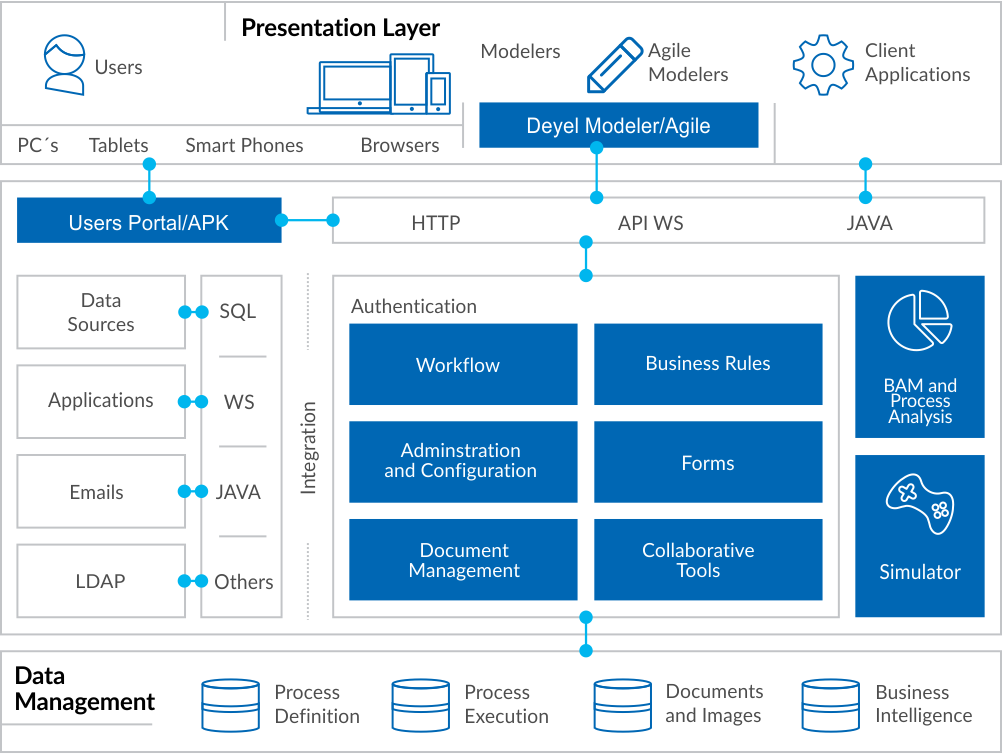Architecture
Deyel is a product based on Java technology, developed with modern object-oriented patterns. It supports several industry standards such as HTML5, CSS3, RWD, web services, multiple database and application servers.
The following chart describes the main components of its architecture.

Graphic Modeler
Using the graphic modeler, business users can graphically design their processes using BPMN 2.0 (Business Process Model and Notation) symbols in an intuitive and easy-to-use environment. Each process with its activities, interconnections, events, times, alerts, etc. can be defined and also documented. In this same workspace, aspects of processes implementation can be included, such as user interfaces of the activities, integration with other applications, variables and business rules, among others.
User Portal
Through the portal of Deyel, users can interact with their list of activities and execute their tasks, start cases of their processes, consult them, access collaborative tools, monitoring reports, etc. The administration and configuration functionality can also be used through the portal. The portal is based on standards such as RWD, HTML5 and CSS3. They can be used on mobile devices or desktop PCs through web browsers. Its appearance is configurable according to the characteristics of each organization.
Workflow Engine
The workflow engine of Deyel interprets and executes the definition of business processes that are modeled in the graphic modeler. The modeler stores the graphically modeled processes within the process repository, so that the workflow engine can interpret these definitions and execute them. The execution state remains in the case execution repository.
Forms Administrator
Through this Deyel tool, forms that represent the user interface of human activities are generated in the modeled processes. Forms contain the process variables that are used by business rules and other related objects.
Forms have an interface rich in components (jQuery and Bootstrap), support RWD (Responsive Web Design) concept and are based on standards such as HTML5 and CSS3.
Business Rules
The behavior of processes is defined by business rules. Rules can be used in validations, specific business logic, process flow control, integration with other applications, etc.
Deyel offers wizards the business user that allow them to intuitively define the behavior of the rule. These wizards present the user with control structures, access to available parameters and variables, previously defined business rules, executing components, logical operators, etc. Rules persist in the object catalog of Deyel.
Collaborative Tools
With the messenger service of Deyel, users can communicate easily. Messages can be used among users in private, or they can be public when they are associated with cases or processes definitions. Associating them with cases provides a collaborative tool among the participants of the case, making these messages part of the case. On the other hand, messages related to the definition of processes enable a direct communication channel to improve processes among the participants of the case and process owners. Also, subscriptions enable an option to choose to receive messages about cases or processes of interest.
Integration
Deyel provides tools and services that allow any application to interact in a bi-directional way with the defined processes. Making use of adapters based on Web Services, Java, JDBC and others, allows to integrate existing applications or data sources.
Deyel also has Java APIs and web services that allow any application to interact with processes through them.
BAM and Process Analysis
Deyel offers powerful capabilities for analysis and browsing of multidimensional structures that allow to analyze the operation of processes and their tasks, both historically (Process Analysis) and in real time (BAM - Business Activity Monitoring).
Through predefined reports, it is possible to observe and understand the operation of processes and detect possible improvements. They analyze in brief the behavior of processes and their tasks, being able to identify what was done on time, with delay, deviations against maximum and expected durations, trends, participant performance, bottlenecks, etc.
The behavioral information is displayed as a grid and through charts, always having the reference of the expected trend curves to contrast against reality. In this way, behavior can be graphically monitored. In all cases, it is possible to drill down into the information, reaching the process level, task, executor, date range, case, etc. Multiple views of the information can be generated by navigating it through multiple dimensions, such as time, priorities, participants, initiators, states of cases and tasks, among others.
Administration and Configuration
The administration and configuration of Deyel allows to define the security and authentication of process participants with their different profiles and roles, their relation with LDAP repositories, workgroups, their districts, calendars, time zones, user portal appearance and also technical aspects of the solution.
